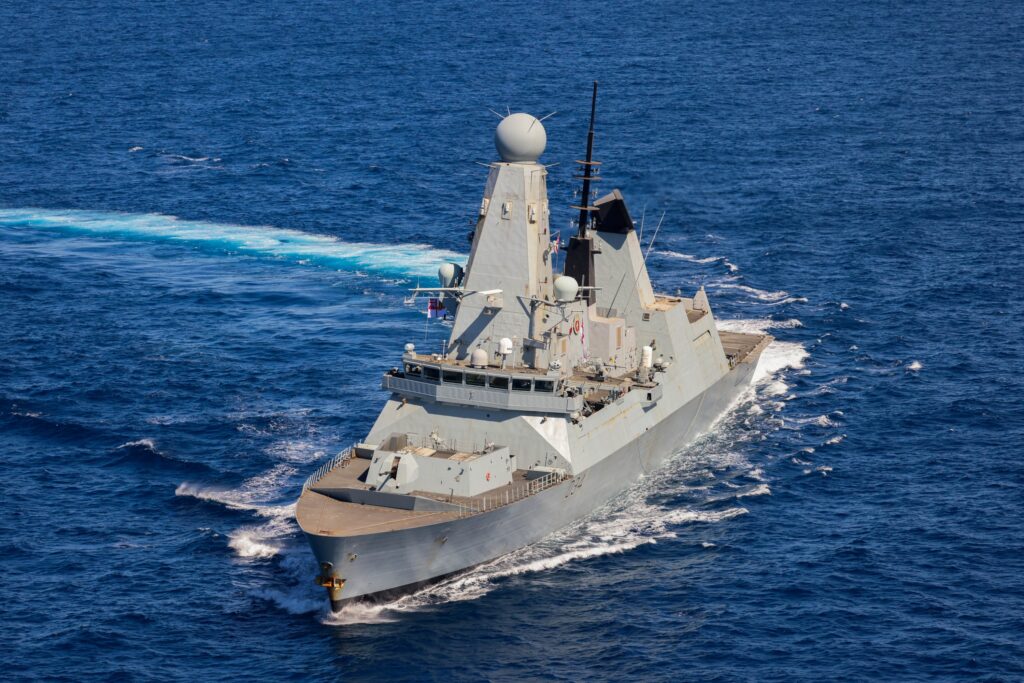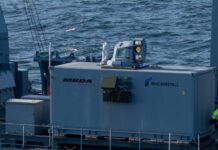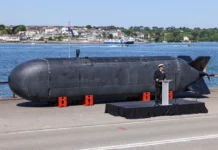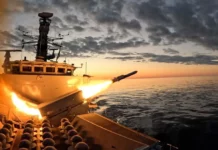The UK Ministry of Defence (MoD) has contracted MBDA UK to fit its DragonFire laser-based directed energy weapon (DEW) onto two Royal Navy (RN) Type 45 air-defence destroyers, in a capability development offering the navy a new deterrence and defence option against a new threat in the modern battlespace.
The GBP 316 million (EUR 360 million) contract – announced on 20 November 2025 at MBDA’s Stevenage site by UK Minister for Defence Readiness and Industry Luke Pollard – will deliver integration of the first ship fit by the end of 2027. In a media briefing Pollard confirmed commitment to four Type 45 ship fits in total.
Delivery of the first by 2027 is five years ahead of the programme’s original planned timeframe.
In revealing the contract Pollard said DragonFire’s development “is an opportunity to have a mix of capabilities to protect our warships in more dangerous times”, adding, “DragonFire doesn’t replace missiles: it’s complementary to missiles; it provides a low-cost ability to defeat threats to those ships.”
DragonFire is being delivered by a consortium of MBDA UK, Leonardo and QinetiQ. BAE Systems is supporting the programme by delivering shipborne integration.
The contract follows the successful completion in October 2025 of the latest testing. Conducted on the UK’s Hebrides range, this involved DragonFire tracking large uncrewed aerial vehicles (UAVs), including some able to travel at speeds of up to 650 km/h, and then targeting and shooting down the UAVs, including (for the first time) in an above-the-horizon engagement process.
The contract also follows the UK Strategic Defence Review (SDR), published in June 2025, calling for delivery of DEW capabilities like DragonFire to create low-cost, sustainable alternatives to missiles.
It also follows lessons learned from recent operations – not just uncrewed systems emerging as a new threat in the modern battlespace in the Russo-Ukraine war (including in operations in the Black Sea), but Yemen-based Houthi rebels’ use in the Red Sea of UAVs, uncrewed surface vessels, and ballistic and cruise missiles to target commercial and naval vessels transiting the region.
These emerging operational requirements have underlined the need for navies to increase their lethality and how that is generated, Pollard explained to media. This need, he continued, is illustrated in the DragonFire programme, including with its accelerated procurement.
“The speed and pace of implementation is what’s significantly changed here,” said Pollard. “That reflects the more dangerous times we’re in – but also a changing approach from the government … to move funding into those cutting-edge technologies that give us the edge. That’s what SDR set out very clearly, and that’s what we intend to do here.”
“With the pace of change we’re seeing in the RN – and the navy [having] the ability through its platforms to seize on … more technology being deployed faster – DragonFire fits perfectly with that pace,” he said.
“We’ve got to increase our lethality. Our deterrence is directly connected to our lethality, and is also directly connected to our industrial capability,” Pollard continued. “As we seek to increase our deterrence and our warfighting readiness, which will help us should we be required to defeat any threat from an adversary, we’re going to have to deploy new technologies and we’re going to have to spiral develop them faster than we have done in the past. … That means changing the way we contract, changing our approach to innovation, changing our approach to risk.
“I’ve absolutely no doubt that DEW will be a significant part of the ability to protect our warships in the future,” the minister continued. “DragonFire is the first iteration of that technology, and when it’s installed on one of our destroyers from 2027, we’ll be able to see how the tactics, techniques and procedures that sit alongside the technology will work to inform how a ship’s company protects itself in a threat environment, using DragonFire as one of the options as part of a layered defence.”














